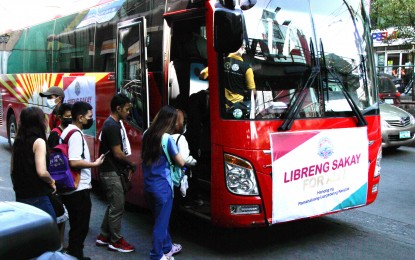
FREE RIDE. Commuters board a 'libreng sakay (free ride)' bus offered by the city government of Navotas along Samson Road, Monumento, Caloocan City on Monday (March 6, 2023). Land Transportation Franchising and Regulatory Board (LTFRB) Technical Division chief Joel Bolano said about 10 percent of public transportation routes have been affected by the strike in the National Capital Region (NCR), with about 5 percent of all routes affected nationwide. (PNA photo by Ben Briones)
MANILA – The transport strike staged by various public transport groups against the public utility vehicle (PUV) modernization program (PUVMP) has affected only 10 percent of routes in the National Capital Region (NCR), the Land Transportation Franchising and Regulatory Board (LTFRB) reported on Monday.
In a press briefing at the LTFRB office in East Avenue, Quezon City, LTFRB Technical Division chief Joel Bolano said rescue buses and “libreng sakay (free ride)” vehicles provided by different government agencies have been deployed in areas affected by the transport strike.
“As of 11 a.m., in Metro Manila, we have only at least 10 percent po ang affected na areas or routes. But again, we have rescue buses and libreng sakay, na-address po. Wala po kaming nakitang nag-build up until now na passengers (that addressed this. We haven’t seen a passenger buildup until now),” Bolano said.
Another region with a similar situation to NCR is Region 4A, which is currently moderately affected by the transport strike.
“Pangalawa sa NCR is Region 4A on a moderate code lang po sila (Next to NCR is Region 4A but they’re only at moderate code). But the rest of the country as of 11 a.m. is at normal operations,” he said.
In total, he said about 5 percent of transport routes nationwide have been affected by the strike.
LTFRB appeals to transport groups to end strike
During the briefing, LTFRB chairperson Teofilo Guadiz III appealed to these transport groups to end their protest as the government is willing to listen and address their concerns through dialogue and consultation.
“We're willing to adjust to your needs. Basta ho ang importante rito ay tayo ay nagkakaintindihan, we have one common denominator at ito po ay ang kapakanan ng mga sumasakay (What’s important is we have an understanding, we have one common denominator, and that is the welfare of the passengers),” Guadiz said.
He announced the extension of the deadline for PUV consolidation and modernization from June 30 to December 31 and will be made official through a memorandum circular that will be released next week.
“During that time, yung iba-ibang deadlines din po para sa completion ng modernization ay iuurong po namin lahat. So, effectively ho, mga hanggang 2024 bago makumpleto yung first phase ng program (During that time, the different deadlines for the completion of the PUVMP will be pushed back. Effectively, the first phase of the PUVMP will be moved back to 2024),” he said.
To date, he said he has already spoken with various transport groups -- including MANIBELA, LABAN TNVS and PISTON which staged the transport strike.
“Marami po kaming napag-usapan ng mga transport groups, galing pa nga akong MANIBELA. Yung deadline is just one of the many things na napag-usapan namin. Isa pa is yung continuing education ng ating mga tsuper para maintindihan nila itong modernization program (We talked a lot with the transport groups, I even came from MANIBELA. The deadline is just one of the many things we talked about. Another is the continuing education of our drivers so they understand this modernization program),” he said.
He noted that LTFRB staff will personally visit transport cooperatives to further explain the intricacies of the PUVMP.
The LTFRB will also rationalize the routes of PUVs to ensure their profitability, as well as assist them in applying for loans from Land Bank of the Philippines, Development Bank of the Philippines, and other financing institutions.
He also clarified that under the modernization program, there will be different types of PUVs aside from the usual white buses and that traditional jeepneys can still operate as long as they comply with safety and environmental standards.
“Mayroon kaming iba from the usual na bus na nakikita niyong puti. Ime-maintain namin yung traditional jeep but subject to modifications para po ito ay mag-conform with the Philippine National Standards. And it will lower the price from PHP2.6 million to only about PHP1.3 million (We have different modern jeepney designs from the usual white ones. We will maintain the traditional jeep but subject to modifications so that it conforms with the Philippine National Standards. And it will lower the price from PHP2.6 million to only about PHP1.3 million),” he said.
Guadiz appealed for understanding and cooperation from transport groups and assured them that the modernization program is not meant to take away their livelihood but rather improve public transportation in the country.
“Marami po kaming iniisip na programa para po maibsan nitong programa ang takot ng ating mga kapatid na ito hong modernization program ay magtatanggal ng kanilang hanap-buhay (We are thinking of many programs to ease the fear of our brothers about this modernization program they claimed will take away their livelihood),” he said. (PNA)
